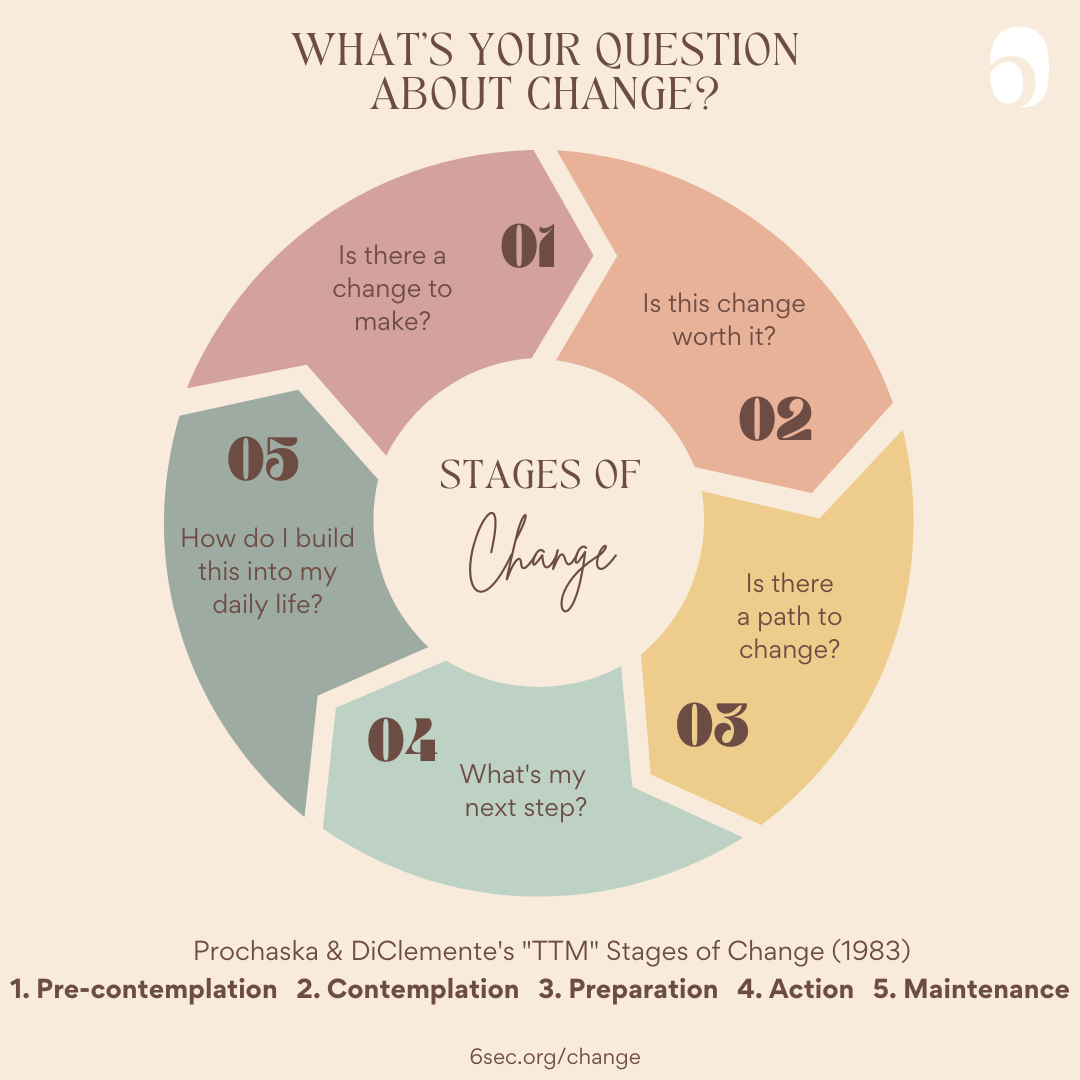When a coaching client says, ‘I have to change’ it raises a crucial question: Who’s driving the change process? Here’s a new way of using the Prochaska & DiClemente Stages of Change model and coaching strategies to make change more effective.
Why ‘I Have to Change’ is a Coaching Red Flag – 3 Solutions from Emotional Intelligence 🌱
“Have to” is a signal of giving away autonomy. While it might sound innocent, or even sound like full commitment, it’s a warning: if the push is from outside, it will become a barrier to sustaining change.
How about “should” “no choice” “pushed” “expected to”… ?
What else do you hear from clients (and in your own head) that might signal a problematic power dynamics around change?
The problem isn’t the words, of course; the words are hinting at an underlying emotional barrier. It’s a rock just below the surface of the river. One way to understand these disruptors is considering the stages of change in Prochaska & DiClemente’s Stages of Change (1983). Is your client, themselves, moving toward change – or are they perceiving that someone else is moving them toward change?
Externalizing is Easier
We shift the responsibility to others and use phrases such as, “I have to” when we’re not able to or comfortable taking full ownership. We shift it to a requirement, expectation, rule… then we become passengers on the ride… and we no longer have to take full ownership for our own choices. While it diminishes our own power, in a way it’s EASIER. When we’re in, “I have to change,” it’s an obligation, but there’s a cost.
From Have to Want: Taking Ownership of Change
When we put someone else in the driver’s seat (ie give up autonomy, or blame someone else, or make it someone else’s responsibility), we put someone else in charge of the change. What’s going to happen when the change becomes hard? What about when we fail, or feel despair and rage and inadequacy in the face of that failure? Conversely, when we make progress, do we feel a sense of ownership for our own growth, have we learned what worked so we could replicate it? Or are we simply meeting external obligations?
Because we are social creatures, of course we’re influenced by the people we care about (only psychopaths have no concern for others’ opinions and feelings). But paying attention to others’ influence is different from giving up our own responsibility or making ourselves into victims.
When reaching “wanting” change from the inside, the power driving the change isn’t subject to someone else’s whim. It’s no longer about expectations or pleasing. In a sense, this is all about the EQ competency of Engage Intrinsic Motivation. When the motivation is growing on the inside, we can step out of our internal power struggle and stop wasting so much energy.
As a coach, when you hear those signals of externalizing the change, you can make an observation and ask: “I think you said, ‘I have to change,’ would you mind telling me a bit more about that? What makes it a ‘have to?”
Then, you can begin to help your client find the Want To: “Apart from what others think, what about this feels important for you?”
This article is from the 🌱 Emotional Intelligence Coach Newsletter
Click here & choose the newsletters that will help you practice and grow emotional intelligence
Coaching for Inside Change
The Prochaska & DiClemente model is widely used around overcoming problems such as addictive behavior. While there’s a lot of valid criticism of the model, it offers useful thinking that helps all of us as coaches supporting change. In the graphic above, I put a question for each stage.
In each of these, we might feel a “tug of war” between self and others. Our friends, family, colleagues might be encouraging, criticizing, inviting, pushing, supporting change. We also might have beliefs about others’ expectations, which can be built on assumptions and often are far from what others really feel and think.
Let’s focus on the first three stages with some tips for moving onto to the inside path for change:

Pre-contemplation: No changes soon
Before we’ve seriously considered a change, we might have glimmers of awareness. We might ask, “Is there a change to make?” – in other words: Are there some problematic costs to the current ‘way things are’ and/or some benefits to trying something new?
| From outside | From inside |
|
This is someone else’s agenda. There might be issues, but that’s not my responsibility. |
I wonder how I might feel if… Am I where I really want to be? |
Coaching tips:
Invite imagination to practice seeing and feeling what it might be like in a different stage. “Describe that future state in more detail.” “Imagine yourself in that state, what might it feel like?”

Contemplation: It might be worth changing
The vague perception of pre-contemplation becomes a clear picture of a different future, but it usually seems difficult to get there. The ‘trick’ in this stage is to move from seeing change as a problem toward seeing it as an opportunity. As the change becomes more visible and attractive, we might ask, “Is this change worth it?”
|
From outside |
From inside |
|
I’m getting a lot of pressure to change. I should do something different. |
I’m not satisfied with the status quo. I feel an urgency to go in a new direction. |
Coaching tips:
Step out of power struggle by reinforcing autonomy, “If you had the freedom to change whatever 1 thing you wanted in this situation, what might you choose?” Connect the present choices to longer term – this is about what we call Pursue Noble Goals: “What is it you really want?” “If you look back on this in 5 years, who do you want to be in this situation?”

Preparation: Setting up for action
Once the vision of change is clear and we see the value, the next step is to figure out how. In this stage we make plans and build momentum toward action. It’s about moving from awareness to commitment. If we’ve decided (in 2) that it’s worthwhile, we start looking for ways to enact the change, and we might ask: “Is there a path to change?” And, as you know from our article on the 3 questions to strengthen motivation: “Will this path work for me?”
|
From outside |
From inside |
|
My ___(person) is telling me that my next steps should be… In my role, it’s important for me to … |
I’ve seen how others do this, and I can see how to adapt that to my situation… Something that might work for me is… |
Coaching tips:
Gain insight on their engagement in the prospective plan by asking about feelings around the plan, eg, “What are some feelings you have right now as you imagine taking that step?” Help your client expand the range of possibilities by looking at many options (exercising optimism helps with this). A tool like Think Feel Act Cards (or the app) can help expand the range of options.
Caution: Individualistic Cultural Bias
In this conversation, I keep thinking about my own cultural norms and values around autonomy. As you know, Six Seconds EQ Coaches work all over the world, with widely varied cultural values about individual and social responsibilities.
From a more individualistic perspective, too much attention on others’ influence could be a signal of dysfunction. From a more collectivist perspective, it’s probably deeply problematic for someone to focus on their own path to change without close attention to their roles and relationships.
So as you have these coaching conversations around autonomy, I recommend also reflecting on your own biases about ‘who should be driving the bus,’ and inviting your clients to do the same. Please share in the comments what you learn as you explore these topics.
Whether you’re a professional coach, or contemplating earning certification as a professional emotional intelligence coach*, or you’re someone who uses coaching techniques to support others: of course these questions apply to us first.
* Did you know? In addition to top-level accreditation from the International Coaching Federation, the EQ Coach Certification is one of a handful of coaching certifications in North America that also provides master’s level credit? You’ll earn almost ⅓ of your MBA or MA in this program.
I’d love to hear what you discover. Please share a comment below!
And, if you have questions you’d like me to explore in a future 🌱 EQ Coaching newsletter and/or video, please post in the comments, or feel free to reach out to me via our contact form.
… and don’t forget to Click here to subscribe to the EQ Coach Newsletter.
For more on EQ and Coaching 🌱, I recommend:
Coaching People in Challenges
- Coaching Through the Emotional Recession: Three Practical Tips for Trauma-Informed Coaching - May 1, 2024
- Knowing Isn’t Coaching: Three Emotional Intelligence Tools for Professional Coaches - April 3, 2024
- Coaching Down the Escalator: 3 Emotional Intelligence Tips forCoaches to Reduce Volatility & De-escalate Conflict in a Polarized World - March 6, 2024

